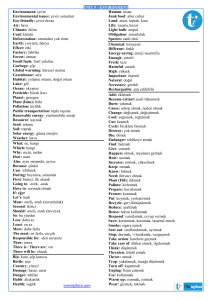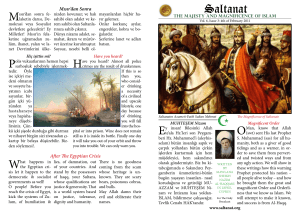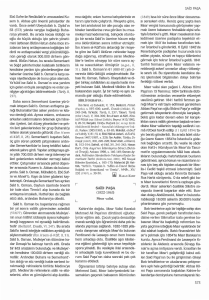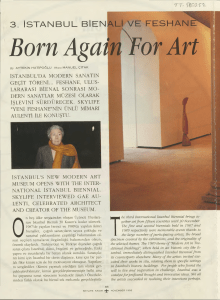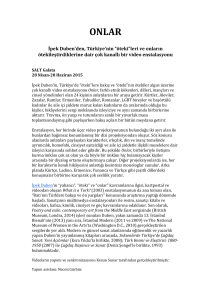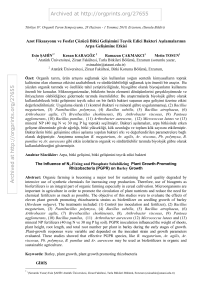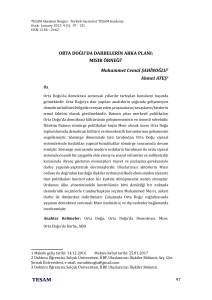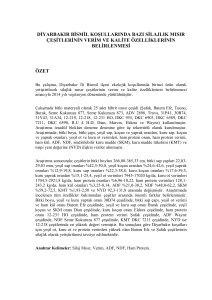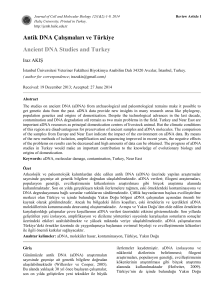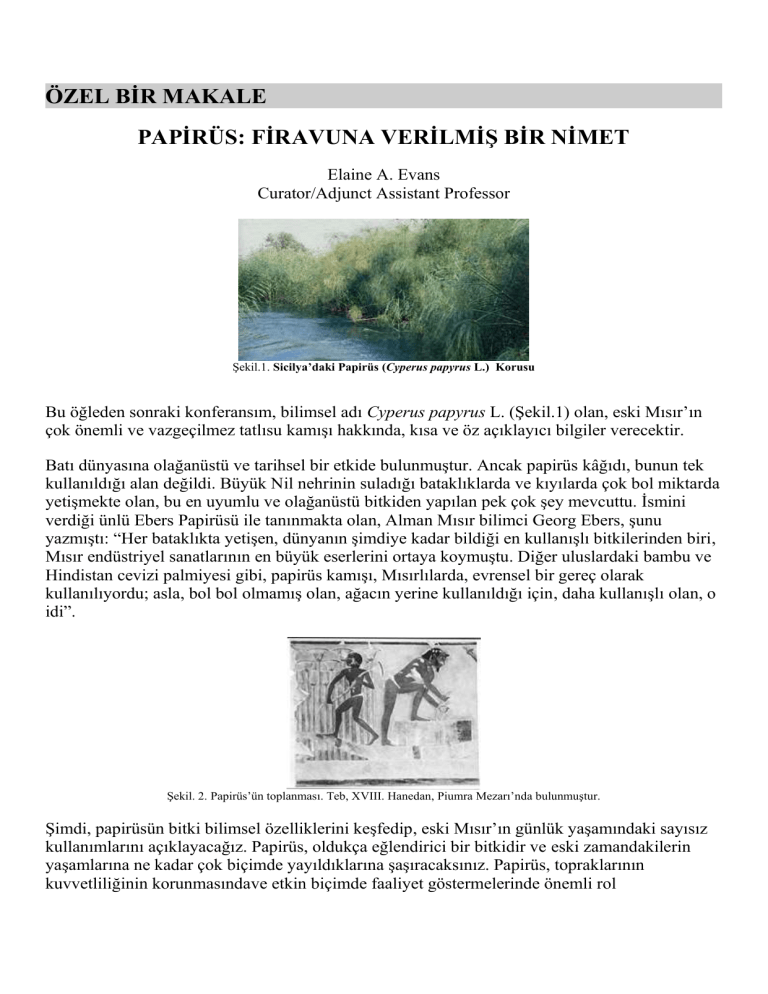
ÖZEL BİR MAKALE
PAPİRÜS: FİRAVUNA VERİLMİŞ BİR NİMET
Elaine A. Evans
Curator/Adjunct Assistant Professor
Şekil.1. Sicilya’daki Papirüs (Cyperus papyrus L.) Korusu
Bu öğleden sonraki konferansım, bilimsel adı Cyperus papyrus L. (Şekil.1) olan, eski Mısır’ın
çok önemli ve vazgeçilmez tatlısu kamışı hakkında, kısa ve öz açıklayıcı bilgiler verecektir.
Batı dünyasına olağanüstü ve tarihsel bir etkide bulunmuştur. Ancak papirüs kâğıdı, bunun tek
kullanıldığı alan değildi. Büyük Nil nehrinin suladığı bataklıklarda ve kıyılarda çok bol miktarda
yetişmekte olan, bu en uyumlu ve olağanüstü bitkiden yapılan pek çok şey mevcuttu. İsmini
verdiği ünlü Ebers Papirüsü ile tanınmakta olan, Alman Mısır bilimci Georg Ebers, şunu
yazmıştı: “Her bataklıkta yetişen, dünyanın şimdiye kadar bildiği en kullanışlı bitkilerinden biri,
Mısır endüstriyel sanatlarının en büyük eserlerini ortaya koymuştu. Diğer uluslardaki bambu ve
Hindistan cevizi palmiyesi gibi, papirüs kamışı, Mısırlılarda, evrensel bir gereç olarak
kullanılıyordu; asla, bol bol olmamış olan, ağacın yerine kullanıldığı için, daha kullanışlı olan, o
idi”.
Şekil. 2. Papirüs’ün toplanması. Teb, XVIII. Hanedan, Piumra Mezarı’nda bulunmuştur.
Şimdi, papirüsün bitki bilimsel özelliklerini keşfedip, eski Mısır’ın günlük yaşamındaki sayısız
kullanımlarını açıklayacağız. Papirüs, oldukça eğlendirici bir bitkidir ve eski zamandakilerin
yaşamlarına ne kadar çok biçimde yayıldıklarına şaşıracaksınız. Papirüs, topraklarının
kuvvetliliğinin korunmasındave etkin biçimde faaliyet göstermelerinde önemli rol
oynuyordu.Mısır firavunlarına kutsanmışlardı.
Papirüs, insanlığın aşina olduğu en eski bitkilerden biridir. Kökeninin, Mısır olduğuna
inanılmaktadır. Uzun, narin bitkinin tarihi; Hanedan Dönemi’nden öncesine uzanmaktadır.
Kültürel gelişimlerinin yüksek olmaları sayesinde, böylesine doğal çevrelerine uyumlu olan, eski
Mısırlılar, bunların pratik kullanımlardaki değerlerini ve potansiyellerini açığa çıkarabiliyorlardı.
Tüm hanedan dönemleri boyunca, papirüs, Firavun ve halkına tatmin ve yarardan başka hiçbir
şey getirmemiştir.
Eski zamanlarda, papirüsün toplanmasını ve üretimini tasvir etmekte olan, mezar duvarı
resimlerinden, bitkinin yarattığı faaliyeti, daha açık biçimde, gözümüzde canlandırabiliriz
(Şekil.2). İşçiler; bataklıklardan, bitki saplarını söküyor; saplarını, demetler halinde bağlıyorlar
ve işlenmek üzere, atölyelere taşıyorlardı.
Gezginler ve Asılsız Bitki
İlk zamanlarda, Diğer eski zaman kültürlerinden ziyaretçiler, Mısır’a geliyorlardı ve her yerde
bu kadar bolca yetişen gür Cyperus papyrus bitkisinden etkileniyorlardı. Eski Yunan
tarihçilerinden Herodot’a (MÖ 450 dolayları) göre, papirüs, “bataklıklardan koparılıyor, tepesi
kesilerek atılıp diğer uçlara dönüştürülüyor ve alt kısmı…yeniliyor ya da satılıyordu”. Elimizde,
Romalı doğa bilimci Yaşlı Pliny’ye (MS 23-29)ait eski bir açıklama da bulunmaktadır ve
kendisi, yazmış olduğu “DoğaTarihi” ansiklopedisinin XIII. Kitabı’nın 71. sayfasında, Nil
Nehri’nin15 fit (4,57 m) yüksekliğe ulaşan bataklıklarında ve durgun sularında yetişen bitki
hakkında bilgi vermiştir.
Şekil. 3. 1798’de, Piramitler’deki Napolyon’un askerleri.
Kaynak: La Description de l’Égypte.
Mısırlıların Djet veya tjufi adını verdiği görkemli, yeşil bitki; günlük hayatlarında, son derece
kullanışlı bir rol oynuyordu, ancak günümüzde, üzücü biçimde, Mısır’da, neredeyse tamamen
ortadan kalkmıştır. Bunun, tam olarak, ne zaman gerçekleştiği bilinmemektedir. Ancak bazıları,
Napolyon, askerleriyle birlikte,Mısır’a gelmeden önce, asıl bitkinin neslinin, Nil nehri üzerinde
tükendiğine inanmaktadır (Şekil.3). Bitki; içerisinde, Mısır’ın bitki örtüsüne (flora) ve direyine
(fauna) adanmış bir bölüm bulunmakta olan, Napolyon’un 19. Yüzyıl başlarındaki ünlü
La Description de l’Égypte başlıklı Fransızca eserinde kayıtlı değildir
Bu durum, bazı bilim adamlarının, bitkinin ortadan kalktığına inanmasına neden olmuştur.
Üstelik, bitki bilimciler içerisinde de anlaşmazlığa yol açmıştır. Konu hakkında, pek çok soru
sorulmuş ancak bunların pek azına yanıt verilmiştir.
982 yılında, İbn Gulgul gibi, ilk Arap yazarları,Nil bataklıklarında boyu uzayan bitkiye
değindiler. Çok daha sonra, Fransız doğa bilimcisi Pierre Belon, 1546-49’da; İtalyan doktor ve
bitki bilimcisi Prosper Albinus ise, daha sonra, 1580’de, Mısır’daki papirüsü işaret etti. Ancak
ünlü İsveçli kaşif ve bitki bilimcisi Fredrik Hasselquist, 1749-50 yıllarındaki gezisinde, bitkiye
rastlamadı. Ancak 1790’daki öncü kitabı Select Specimens of Natural History collected in
Travels to discover the Source of the Nile in Egypt, Arabia, Abyssinia, and Nubia’da (Mısır’daki,
Arabistan Yarımadası’ndaki, Etiyopya’daki ve Nubiya’daki Nil Nehrini Kaynağının Keşfi
Gezilerinde Toplanan Seçme Doğa Tarihi Örnekleri), İskoç gezgin James Bruce (1730-1794),
Mısır’daki papirüsün hakkında yazmış ve kökeni konusundaki görüşlerini şöyle ifade etmişti:
“Papirüs, bana, daha önce, buraya, Etiyopya’dan inerekgelmiş ve Yukarı Mısır’da kullanılmış
gibi görünmektedir…”
Fig. 4 Engraving of Papyrus, circa 1790. From J. Bruce, Select Specimens of Natural History…. London 1790.
Bruce, bitkiyi ayrıntılı olarak açıklamamış, ancak gravür tekniği ile yapılmış resmi (Şekil.4),
kitabında, bir çizim olarak görünmekte ve tercihen, Mısır’da, birkaç yıl sonra yetiştiği keşfedilen
bitki ile karşılaştırmaktadır.1820-1821 yıllarında, Prusya ordusu subayı olan, Baron Heinrich C.
M. Minutoli (1772-1846), bir zamanlar, yüz ölçümü, 660 milkarelik (1.709,40 km2) Manzala
Gölü kıyısında olmasının yanında, Nil Nehri’nin doğu kıyısında ve Kahire’nin 125 mil (201 km)
kuzeydoğusunda olan, Dimyat şehrindeki Nil Deltası’nın çeşitli yerlerinde yetiştiğini bulmuştur.
Ancak, 1897’de, Mısır bitkileri hakkındaki birkaç kitabın yazarı olan, seçkin Fransız bitki
bilimcisi G. Delchevalerie; yazılarında, Mısır’da, papirüs bitkisinin tamamen tükendiğine
değiniyordu. Kendisi, şunu ifade ediyordu: “1872’de, Mısır’a getirilen 12 bitkiyi verdiğimiz ve
bunları, Kahire’nin Choubra (Subra) mahallesine ve Kahire’deki diğer bahçelere diken,
Paris’teki Lüksemburg Bahçesi’nin Baş Bahçıvanı olan, A. Riviere’ye mahkûm kalmıştık.”
Bazı bilim adamları, Mısır’da yetişen türün, günümüzde, muhtemelen, Fransa’dan getirilen bu
bitkilerden türediğine inanmaktadır. Ancak, bitki bilimciler Vivi Täckholm ve Mohammed Drar,
yine de, 1950 yılına ait Flora of Egypt (Mısır Bitkileri) kitaplarında, bir zamanlar, tükendiğine
inanılan Cyperus papyrus’un Natrun Vadisi’ndeki Umm Risha Gölü’nde yeniden keşfedildiğini
iddia etmişlerdir. Ayrıca, Kahire’deki Papirüs Enstitüsü’nün Müdürü olan, Hassan Regab, 1980
yılındaki kitabı Le Papyrus’ta, eski zamanlardan kalma bitki olduğuna inanmakta olduğu,
Natrun Vadisi papirüsünü yakından incelemiş ve Nubiya’daki ve Sudan’da bulunanlarla aynı
olduğunu keşfetmiştir.
Cyperus papyrus, dünyanın çeşitli yerlerinde tanınan, muhtemelen, 4.000 türe sahip geniş bir
çim benzeri bitki ailesi olan,Cyperaceae(Sazgiller) ailesine mensup bir türdür. Bir zamanlar, Nil
nehri boyuncaki bataklıklarda bol miktarda yetişmiş olan, uzun çiçekli bir sazdır. Bitki,
beslenmesini gerçekleştirmekte olduğu, zangin, sulak ve çamurlu alanlardaki bu bereketli
sularda iyi gelişiyordu. 1875’te, W. T. Thiselton-Dyer, bunu, şöyle açıklamaktadır: “Ortadan
kaybolmasının sebebini, muhtemelen, herhangi bir iklim değişikliğinde değil,muhtemelen,
suyunun dönemsel yükselişi ve alçalması halinde, nehrin fiziksel koşullarında aramakgerekir –
insan müdahelesi olmadan da, nedeninin, buna dayandırılması mümkün değildir. Ayrıca, Delta,
alüvyonla doldu ve bu da, MÖ 12. yüzyılda, onun, tuzlu bir bataklığa dönüşmesine yol açtı.
Böylece, bir tatlı su bitkisi olan, papirüs, kaçınılmaz olarak yok oldu. Çok daha sonra, papirüs
dışındaki malzemelerden kâğıt üretildiğinde, artık, bitkinin tarımının yapılmasına gerek kalmadı
ve nesli tükendi.
Papirüsün Özellikleri
Hassan Regab tarafından araştırılan Cyperus papyrus, onun mükemmel özelliklerinin daha iyi
anlaşılması için, iyi bir örnek oluşturacaktır. Hassan Regab, Enver Sedat’tan, Mısır’a önemli
katkılarından ve özellikle Mısır papirüsü ile yaptığı çalışmalardan dolayı, Mısır Cumhuriyeti
Baş Nişanı’nı almıştır. Cyperus papirüsüne yakından bakış, onun temel bitki bilimsel
özelliklerinin birkaçına odaklanmamızı sağlayacaktır. Hassan Regab, bitkiyi, enine boyuna
açıklamasına rağmen, anlaşılması güç hücre sistemi haricinde, çok karmaşık yapısının tek bir
kısmı aydınlatılacaktır.
Şekil. 5. Papirüs bitkisinin şemsiye biçimindeki çiçek durumu. Kaynak: H. Ragab, Le Papyrus. Cairo 1980.
Olgun, açık haldeki çiçeklerden oluşan şemsiye şeklindeki çiçek durumu (Şekil.5); sapından
birleşen ince, çubuğumsu sürgünlerden oluşmaktadır. Şemsiye şeklindeki çiçek durumu ya da
ardışık sarkık gövdelerindeki tam başakçık çiçek kümesi veyahut sayısız ince şemsiye şeklindeki
ışınlar, şemsiye şeklindeki çiçek durumunun, güneş şemsiyesine ya da yelpazeye benzemesine
yol açar. Her bir bitkinin, şemsiye şeklindeki çiçek durumunu desteklemekte olan, uzun, düzgün
bir sapı vardır. Saplar, 4 m ya da daha fazla yüksekliğe ulaşır. Şekli; üç köşeli, dayanıklı,
pürüzsüz, yapraksız, düğümsüz, konik olup; geniş, mızrak şekilli yapraklarla çevrili olduğu,
taban kısmı kalındır. Dirençli yaprakları, sapın tabanındadır. Bu kınımsı pullar, Cyperus’un pek
çok türünde farklılık göstermektedir. Cyperus papirüsü durumunda, taban yaprakları, bataklığın
suyuyla çevrili olup kestane renklidirler (Cyperus’un diğer türlerinde, yapraklar, suyun üzerinde,
çok büyük yüksekliklere ulaşacak biçimde gelişirler ancak yeşil renklidirler). Bunlar, güneş
ışığında, klorofilin fotosentezi başlatması ve karbon dioksitin ve suyun karbonhidratlara
çevrilmesi işlevini görmektedirler. Ortalama adedi, 7 olmakla birlikte,bordo renkli yapraklarının
sayısı, 5-9 adettir. Yapraklarının en uzun olanı, gövdeye en yakın olanıdır
Şemsiye şeklindeki çiçek durumları ve saplar nereden gelişmektedir? Bunlar, üst yüzeyinden,
yapraklı sürgünleri ve alt yüzeyinden ise, sürgünleri çıkaran, yatay, köke benzeyen bir gövde
olan, rizomdan gelişmektedirler. Rizomlardan bahsettiğimizde, çoğunlukla, kalın ve beslenme
için gereken kaynakları içeren, genellikle, yatay konumda olan, bitkinin ilk büyümesini
gerçekleştiren, toprak altındaki kökü aklımıza getiririz. Çek Mısır bilimcisi Jaroslav Cerny
rizomu şöyle açıklamaktadır: “…tamamen toprağın içine batmış halde bulunmaktadır, ancak
birçok gövde, tek bir kökten filizlenmekte ve çoğunlukla, 3-6 m yüksekliğe ulaşmakta ve
tepesinde, çiçekler bulunmaktadır.
Fig. 6. H. Ragab’a göre, rizom (Le Papyrus. Kahire, 1980)
Resim (Şekil.6), eski, çürüyen bir rizomdan yatay olarak, genç bir rizomun gelişimini
göstermektedir. Dik sürgünler, minik köklerin desteklerinin, havalandırılmış genç gövdelere
geliştikleri yerlerde ortadan kalkmaktadır
Başak, ortadaki saplarından filizlenmekte bulunan, dallanan, başağımsı tomurcuklardan
oluşmakta olan, uzun bir çiçek kümesidir. Başağın desteği, çeşitli uzunluklarda gelişmektedir ve
tomurcuklar, her bir sapta, sayıca değişmektedirler. Her bir başak, kabuğa benzemekte olan, 20
kadar çiçek vermektedir. Bunlarda, ne çanak yapraklar ne de petaller; yani, ne dıştaki taban
yaprakları ne de içteki petaller veya yapraklar yer almamaktadır.
Şekil. 7. Şemsiye biçimindeki çiçek durumunun gelişimi. Kaynak: H. Ragab, Le Papyrus. Cairo 1980.
Şemsiye biçimindeki çiçek durumunun gelişiminin 3 safhası vardır (Şekil.7). Sap yapısı,
gövdenin kap benzeri kalın uçlu yapraklarından açılmaktadır. Minik, ince tekerlek parmakları ya
da yapraklar, kınlarından, yelpazeye benzeyen şemsiyeyi oluşturacak biçimde çıkarlar. Bir başak
ya da çiçek kümesi, ince, sarkık saplardaki birleşme noktalarının her birinin üzerinde
toplanmaktadır.
Papirüs Kağıdı
Elbette, eski Mısır’ı düşündüğümüzde, papirüs kâğıdı aklımıza gelir. Mısır, onun mucidiydi.
Gerçekten, muhtemelen, hakkında, hiçbir şey bilmesek dahi, kağıt olarak, papirüsü düşünürüz.
Aslında, papirüsün ana önemi, yazıma ve resimle göstermelere uygun yüzeyinin olmasıydı.
Yazma gereci olarak, papirüsün, Mısır’da, tam olarak ne zaman yaratıldığı, halen
bilinmemektedir. Mısır ve eski dünya tarihi hakkındaki pek çok şey, papirüs kâğıdına kayıtlı
olarak, elimize ulaşmıştır. Ayrıca, bir kitabın resmi olarak kabul edilmekte olan, bir papirüs
rulosunun resim yazı simgeleriyle açıklanmış olarak, MÖ 3.100 dolaylarında, I. Hanedan
tarafından kullanıldığını biliyoruz. Bu tür papirüs ruloları, ilk yerleşim yerlerinde bulunmuştur.
I. Hanedan’dan, Hamaka’nın mezarında, bir papirüs rulosu keşfedilmiştir, ancak, ne yazık ki,
boştu. Giza yakınındaki Kral Neferirkere’nin tapınağında, artık, Kahire, Berlin ve Londra’daki
University Colloge’de bulunmakta olan, MÖ 2477-2467 yıllarına ait, V. Hanedan döneminden
kalma, küçük parçalar bilinmektedir. Bu nedenle, Erken Hanedan ve Eski Krallık dönemlerinde,
bunun üretildiğini biliyoruz.
Şekil. 8: Kha’nın Papirüsü. Prof. A. Basile’in kopyası.
Fazlasıyla, papirüs kağıdı, pek çok yerde ancak çoğunlukla mezarlarda bulunmuştur. İlk örneği
ise, muhtemelen, Teb’deki Deyrü'l Medine’de, İtalyan mısır bilimcisi Ernesto Schiaparelli’nin
yaptığı kazılarda, 1903-1920 yıllarında,(Yeni Krallık, XVIII. Hanedan, MÖ 1386-1349
dolaylarına ait)ustabaşı Kha ile karısı Merit’in mezarındaki bir tabutta bulunmuştur. 16 m
uzunluğundaki papirüs, aslı Torino, İtalya’daki Mısır Müzesi’nde bulunmakta olan “Ölüler
Kitabı”nı tasvir etmektedir. 1989’da, Tivoli, İtalya’daki Museo Didattico del Libro Antico’nun
(Antik Kitap Eğitimi Müzesi) müdürü Profesör Antonio Basile; özellikle, Knoxville, Tennessee
Üniversitesi, Frank McClung Müzesi Mısır Galerisi için gerçek papirüsün ilk metresinin tam bir
kopyasını yapmakla görevlendirildi. Papirüsün bir bölümü, Ahiret’teki gölgeliğinin altında
oturan büyük Ölüler Tanrısı Osiris’in huzurunda, ölü Kha ile karısını resmetmektedir (Şekil.8).
Papirüs ruloları ve onun üzerindeki belgeler, tahta sandıklarda, kavanozlarda ya da kutsal
heykellerde saklanıyordu. Sandıklar, çoğunlukla, yazmanların önündeki yerde duruyor biçimde
simgeleniyordu. Mısır’ın Gebelein V. Hanedan mezarından gelen hemen hemen tamamlanmış
papirüs ruloları, Teb’deki III. Ramses’in XIX. Hanedan tapınağı olan, Büyük Ramses Anıt
Tapınağı’nın (Ramesseum) arkasındaki mezardaki papiruslar gibi, basit, dikdörtgen, ahşap bir
kutu içerisinde bulunuyorduChests are often represented standing on the ground in front of
scribes. Five, almost complete papyrus rolls from a Dynasty V tomb at Gebelein, were found in
a simple, rectangular, wooden box as were the papyri in a tomb behind the great Ramesseum, the
Dynasty XIX temple of Ramesses III at Thebes. Although some boxes were labeled, they
probably come from a kind of repository of royal personages. There is no evidence regarding the
organization of a library in ancient Egypt before the great Museum-Library at Alexandra of the
Ptolemaic Period, 332-30 B.C. There were royal administrative archives, where official
daybooks, business letters and accounts were stored. Some were called “Place of Documents of
Pharaoh” and there were also private repositories.
Much information about the Greek civilization has come down to us through papyri. Egyptian
papyrus became the basic writing material for the Greeks. In the Ptolemaic Period, when Greek
pharaohs sat on the throne of Egypt, high quality papyrus production and trade was under royal
ownership, a monopoly in the control of Pharaoh. It was also a material imported throughout the
Near East. Papyrus was mainly used by the literati, for legal papers, and affairs of state.
As C. H. Roberts noted:“Centuries before Alexander’s conquest had made the Greeks the
masters of the country, Egypt had manufactured papyrus paper by a carefully guarded
processes…. The Egyptians had made of it the finest writing material known…indeed, without
such a relatively cheap and convenient material literature and the sciences could scarcely have
developed as they did….” 7 Apparently Egypt was able to keep its process a deep secret and
maintain its monopoly.
Egypt went on to supply the whole Roman Empire. What a wonderful invention, so light,
portable and easy to record information via a reed pen, compared to the “more cumbersome or
more expensive writing material, such as stone and metal plates, wooden and clay tablets, or
leather.” 8 But, alas, paper made of parchment arrived in the Second Century A.D. and later linen
came along from China by way of Baghdad in the Eighth Century A.D. The fragile papyrus
paper was no longer in demand.
Luckily, though, many writings on papyrus by the ancient Egyptians did manage to survive,
mainly in fragmented form. They are preserved in museums and institutions all over the world.
The ancient Egyptians did not leave the method of making papyrus paper, but only wall
paintings of its being collected.
Although we have no record of how they produced the paper, modern scientists have
experimented with the plant. The following steps are probably quite close to the method used:
1.
2.
3.
4.
5.
6.
Soak freshly cut stalks in water;
Remove green rind;
Split the soft pith in strips of finger width;
Arrange strips side by side on a damp board;
Arrange second layer of strips side by side atop the first strips in the opposite direction;
Press the two layers together (pound with a mallet, or stone for several hours) and they
become naturally stuck together by the sticky substance of the pith;
7. Leave the resultant sheet to dry;
8. Polish the paper with a piece of ivory, shell, or smooth stone to flatten and smooth
roughness,
9. The ends can be overlapped and hammered together to make longer sheets.
Fig. 9. Cast of the Narmer Palette. On loan to the McClung Museum from the Metropolitan Museum of Art.
Papyrus as a Symbol of Egypt
The plant may have become the symbol of Lower Egypt as early as the fourth millennium BC.
The plant is illustrated on one side of the famous Narmer palette of Dynasty I, circa 3100 B.C., a
bronze replica of which is on exhibit in the McClung Museum’s Egyptian Gallery. Horus stands
over his enemies, the marshland people of Lower Egypt symbolized by papyrus (Figure 9.).
Another early example in relief are the papyrus stalks with round umbels on the well known
fragment of an ivory club, now in the Cairo Museum. It depicts King Zer, or Scorpion King of
Dynasty I, seated on his throne, with the plant in the background. Among the many fine
examples is the relief at the Temple of Abu Simbel, built in Dynasty XIX by Rameses II, of a
composite emblem of the twined plant symbolizing Lower Egypt in the “Union” of Upper and
Lower Egypt.
Papyrus Boats
Uses for the plant were endless. They show the artistic, inventive and practical character of the
ancient Egyptians in utilizing this most important natural resource that surrounded them. Even
the Roman naturalist Pliny noted aspects of the plant’s diversity and wrote, “…indeed they plait
papyrus to make boats, and they weave sails and matting from the bark and also cloth, blankets
and ropes.” 9 For a culture that would not have existed were it not for the Nile River, boats were
essential for survival. Egyptian men were the boat makers. They cut down and tied the papyrus
stalks and carried them to a place where they could best construct them. There the mature
papyrus stems were tightly bound together into an oblong slim shape. A light portable boat was
the result. (Figure 10.). These boats were used to collect papyrus as it could navigate marshes.
Also papyrus fibres were woven together and occasionally made into sails, or twisted into ropes
for the small boats. Small skiffs were made by fishermen as they served well for fishing and
laying of traps or drag-nets. The seams of the larger wooden boats were caulked with papyrus
and the rigging was made of papyrus fibres. Papyrus was also used for light cabins on boats.
Fig 10. A Boat Decorated with Papyrus. From G. Ebers,
Egypt: Descriptive, Historical, and Picturesque. London 1879.
James Bruce commented about additions made to a papyrus boat and its restriction to local use:
“The Egyptian ships, at that time (Sesostris I, Middle Kingdom, 1971-1928 B.C.), were all made
of reed papyrus, covered with skins or leather, a construction which no people could venture to
present to the ocean.” 10 Ships of wood are known as early as the Old Kingdom. Some were as
long as 100 feet, probably made of acacia, and some with papryus sails. Some had the stern and
port carved in the shape of papyrus (Figure 11.).
Fig. 11. Making a Papyrus Boat. From G. Wilkinson,
The Manners and Customs of the Ancient Egyptians. London 1878.
Papyrus in the Household
Fig. 12. Woven Box on Stand. From G. Wilkinson, The Manners and Customs of the Ancient Egyptians. London 1878.
Peasants as well as the wealthy had many useful items made of papyrus in their dwellings.
According to Pliny the stalks were used as wood for fires but also to make utensils and
containers. There were boxes, chests, crates and baskets to store goods such as wigs, toiletries,
food, writing equipment (Figure 12.).
There were bottle stoppers, balls and needle cases. Among other things papyrus rope was used in
webbing for beds, woven floor mats and matting for walls. Papyrus curtains were made as doors
that could be rolled up and down. Trays, stools with reed webbing, tables laden with food, and
sandals are some of the household objects that were made of papyrus. Also, it was used for jar
sealings. Amphora and other pottery vessels containing food and various liquids had the mouths
sealed by papyrus. Some seals were woven and sometimes the papyrus was just stuffed in the jar
mouth as a safeguard. Strands of papyrus pith were used as ties around documents and letters.
Medical Papyrus
Then there were numerous medical uses as is documented in the Ebers Papyrus and in the Edwin
Smith Papyrus, a sample section of which is on exhibit in the McClung Museum’s Egyptian
Gallery. Dried papyrus was used for expanding and drying fistulae and as an aid to open an
abscess for the application of medicine. Burnt papyrus ash was a caustic remedy. Dioscorides
(A.D.78 ) in the lst century A.D. wrote that the ash cures mouth ulcers from spreading. The ash
was also used for diseases of the eye and if added to wine it induced sleep. The plant itself with
water was known to cure skin calluses.
Papyrus and Food
Papyrus as food was mentioned by Herodotus, who said the annual plant was collected and the
lower part eaten. The starch filled rhizomes were consumed raw or roasted and tasted even better
after being baked in a red hot oven. The Greek botanist Theophrastus (ca. 370-288 B.C.) claimed
it was of greatest use as food. Egyptians chewed the papyrus raw, swallowed the juice and spit
out the remains. The Roman historian Diodorus of Sicily wrote, circa 60-30 B.C., that children
were served stews along with raw, roasted, boiled, or baked, stalks of the plant. Pliny the Elder
tells us that the root was a food for the peasant classes. He also noted that it was used as chewing
gum both in the raw and boiled states.
Fig. 13. Bastet Holding a Papyrus Scepter. From G. Wilkinson, The Manners and Customs of the ancient Egypians. London 1878.
Papyrus as Amulets
Amulets were worn suspended from a cord around the neck, as part of a broad collar, or sewn on
mummy wrappings. One of the numerous faience amulets was the papyrus amulet, prized for its
powers of regeneration, or rebirth as in renewed life. Another type of papyrus amulet was the
hypocephalus, a circular piece of new papyrus inscribed with Chapter 162 from the “Book of the
Dead.” Symbolic of the sun, the protective disk was placed beneath the head of the mummy to
insure the deceased would have abundant warmth in the afterworld as on earth. Goddesses are
depicted grasping a papyrus scepter, a long, thin shaft surmounted by a triangular umbel (Figure
13.).
Papyrus for Floral Bouquets and Funeral Garlands
Images painted on tomb walls frequently depict papyrus umbels used in feasts and funeral rites.
Guests hold them in their hands at feasts, or praying persons in religious ceremonies. Servants
carry papyrus stalks as common offerings to the gods. Papyrus was a precious gift on the altar
and on the offering table in the temple. We also see the umbel as an ornament on walls, kisoks,
tables, etc. In many tomb paintings there are depictions of “papyrus swathes” bundles of flowers
and plant foliage tied around a central bunch of papyrus stalks. The feathery umbels on long
stalks were ideal for these composite floral decorations in temples and tombs. It might be noted
the stalks were used as a twine for attaching other flowers, the fibres used for stringing the
flowers. The pith was shaped into artificial flowers.
Fig. 14. Fowling Scene from the Tomb of Nakht. Copy by Richard Greene of Knoxville.
Papyrus in Paintings and Reliefs
Papyrus is represented in many paintings and temple reliefs as well as an important part of daily
life. Among the numerous examples is the papyrus prominently featured in the wall painting of a
marsh scene of fowling in the Dynasty XVIII Tomb of Nahkt at Thebes, which was recreated for
the Egyptian Gallery of the McClung Museum. (Figure 14).
Also is the fragment in the Metropolitan Museum of Art of a garden scene from from the tomb
of Ipuy at Thebes, and in the Cairo Museum the painted papyrus clusters decorating the palace
floor at Amarna. Sandstone reliefs at the mortuary temple of Rameses II at Abu Simbel depict
prisoners strung together with papyrus and on painted friezes on the dais of the thrones of
pharaohs.
Papyrus and Architecture
The papyrus symbol is often an essential feature in the small (Figure 15.) as well as the
large.Towering papyrus form columns and pilasters in palaces and temples abound. Among
many examples, the earliest is dated to the Dynasty III of the Old Kingdom, in the handsome
papyrus-form pilasters on the building façade of the pyramid complex of King Djoser at
Saqqara. The stalk on the pilaster is triangular in outline as is found on the plant. The style was
replaced by the clustered type so common to later Egyptian temples. The Hypostyle Hall in the
Temple of Amun at Karnak is an exceptional example (Figure 16.),the famous, scale model of
which can be seen in the McClung Museum’s Egyptian Gallery.
Fig. 15 Ointment box decorated wih papyrus. From
Fig. 16. Model of the Hypostyle Hall.
G. Wilkinson,
On loan to the McClung Museum from the Metropolitan Museum of
The Manners and Customs of the ancient Egyptians.
Art.
London 1878.
Here the papyrus is full blown and in the round. The column tapers and is encircled by pointed
leaves at its base and the capital in the form of an umbel. Also at Karnak is a towering pillar
decorated in high relief with the symbolic papyrus stalks, erected by King Thutmosis III in
Dynasty XVIII. Private dwellings were decorated with papyrus columns and pilasters as well.
Papyrus Today
Today, what might be the ancient species is now found growing naturally in the Wadi Natron, an
oasis area just west of the Delta in Egypt as was mentioned earlier. This survivor may be the
ancient species, but there are so many variants that problems have arisen in pinpointing the exact
ancient plant species. Interestingly, a continuous growth of what some have judged to be the
ancient plant is still profuse along the White Nile in the southern Sudan, some 1,500 miles south
of the Egyptian border, alluded to by James Bruce. Various species of papyrus are found in other
parts of the world, including the United States, and the continent of Africa such as in large areas
of west, east and central Africa and on the island of Madegasca. The papyrus groves of Sicily are
thought derived from papyrus introduced from Egypt by the Arabs in the 10th century A.D.
* This paper was given Sunday, June 30, 2002, in the Frank H. McClung Museum at the
Univeristy of Tennessee, Knoxville in conjunction with “Pharaoh’s Harvest,” a travelling
exhibition about ancient and modern Egyptian plants, and also to provide a better understanding
of the nature of the papyrus as exhibited in the McClung Museum's Egyptian Gallery.
Notes
1.
2.
3.
4.
5.
6.
7.
8.
9.
10.
Erman, Adolf, Life in Ancient Egypt. London: Macmillan and Co., 1894, p. 447.
Herodotus, II, 92.
Bruce, p. l.
Tackholm and Drar, p. 134.
Tackholm and Drar, p. 140.
Cerny, p. 5.
Roberts, p. 251.
Cerny, p. 4.
Pliny, XIII, 71.
Bruce, vol. 1, p. 370.
Selected Bibliography
See Also: PDF version of the bibliography
Basile, Corrado and Anna di Natale, Il museo del papiro di Siracusa , Quaderni dell’associazione istituto
internazionale del papiro-Siracusa IV. Siracuse: Assessorrato dei Beni Culturali e Ambientali e della
Pubblica Istruzione della Regione Siciliana, 1994.
Bierbrier, M. L. (ed), Papyprus: Structure and Usage. British Museum Occasional Paper 60. London: British
Museum, 1986.
Breasted, James Henry, The Edwin Smith Surgical Papyrus: published in facsimilie…. University of Chicago
Oriental Institute Publications, v. 3-4. Chicago : University of Chicago Press , 1991 (from 1930 original).
Cerny, Jaroslav, Paper & Books in Ancient Egypt . London : H.K. Lewis & Co, ca, 1947.
-----------------, “The Contribution of the Study of Unofficial and Private Documents to the History of
Pharaonic Egypt ” in Le Fonti indirette della storia egiziana. Studi Semitici 7. Rome : Univeristy of Rome ,
1963, pp.31-57.
Drenkhahn, Rosemarie, “Papyrus, -herstellung” in Lexikon der Ägyptologie. Wiesbaden : Otto Harrassowitz,
1982, 667 670.
Lewis, Naphtali, Papyrus in Classical Antiquity. Oxford : Clarendon Press, 1974.
Lucas, Alfred and J. R. Harris, Ancient Egyptian Materials and Industries. London : Edward Arnold Ltd.,
1962.
Parkinson, Richard and Stephen Quirke, Papyrus. London : British Museum Press, 1995.
Ragab, Hassan, Le Papyrus. Cairo : Dr. Ragab Papyrus Institute, 1980.
Roberts, C. H., “The Greek Papyri” in S. R. K. Glanville (ed.), The Legacy of Egypt . Oxford : Clarendon
Press, 1963, pp. 249-282.
Tächholm, Vivi and Mohammed Drar, Flora of Egypt , Vol II. Bulletin of the Facultyof Science, No. 28.
Cairo : Fouad I University Press, 1959, pp. 99-163.
Kaynak: http://mcclungmuseum.utk.edu/research/reoccpap/reoccpr_pyrs.htm




